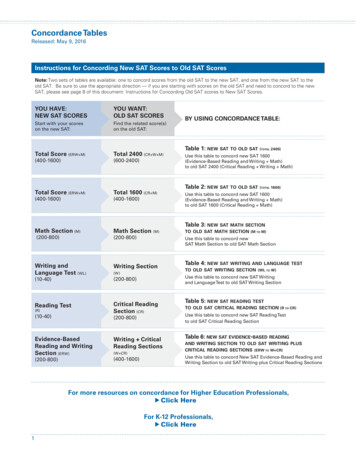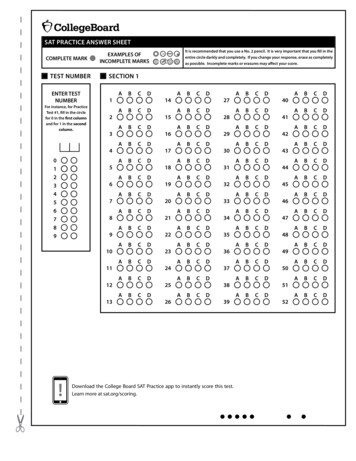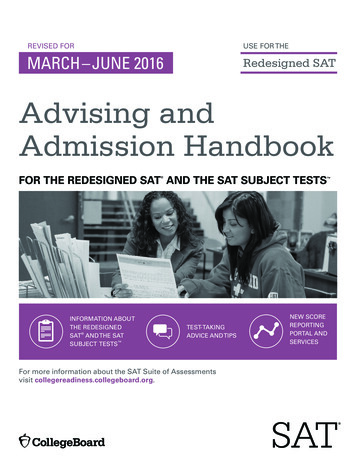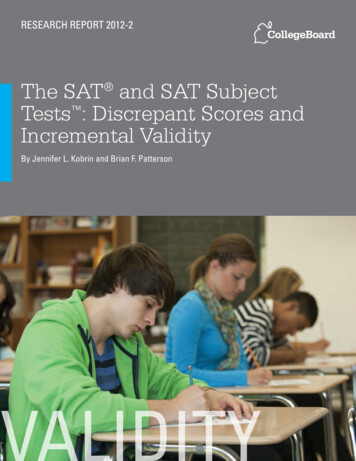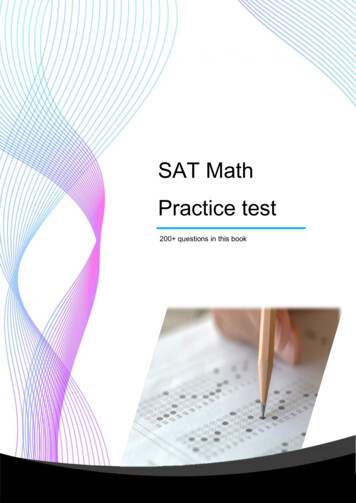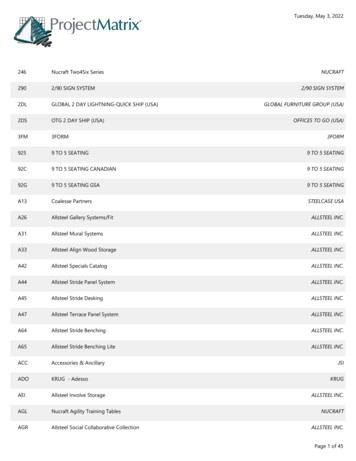
Transcription
SATWRITINGESSENTIALS
SATWRITINGESSENTIALS NEWYORK
Copyright 2006 LearningExpressAll rights reserved under International and Pan-American Copyright Conventions.Published in the United States by LearningExpress, LLC, New York.Library of Congress Cataloging-in-Publication Data:Starkey, Lauren B., 1962–SAT writing essentials / Lauren Starkey.p. cm.ISBN 1-57685-532-51. English language—Composition and exercises—Examinations—Study guides. 2. SAT(Educational test)—Study guides. I. Title.LB1631.5.S785 2006378.1'662—dc222005027520Printed in the United States of America987654321ISBN 1-57685-532-5For more information or to place an order, contact LearningExpress at:55 Broadway8th FloorNew York, NY 10006Or visit us at:www.learnatest.com
About the AuthorLauren Starkey is a writer and editor who specializes in educational and reference works. Her thirteen years of experience include eight years on the editorial staff of the Oxford English Dictionary. The author of more than ten volumes, Lauren lives in Essex, Vermont, with her husband and three children.v
ContentsCHAPTER 1CHAPTER 2CHAPTER 3Getting to Know the Writing Section of the New SAT1Old versus New1Strategies for Test Taking2Scoring4SAT Study Timetable5The Multiple-Choice Section11Identifying Sentence Errors12Improving Sentences32Improving Paragraphs45The Essay55Strategies for Timed Essays56Understanding the Prompts58The Art of Persuasion59Anatomy of an Essay59Planning Your Essay65Drafting Your Essay68Essay Writing Workshop69vii
– CONTENTS –CHAPTER 4Practice Test 175CHAPTER 5Practice Test 2103CHAPTER 6Practice Test 3133viii
SATWRITINGESSENTIALS
C H A P T E R1Getting to Knowthe WritingSection of theNew SATFor over 80 years, high school juniors and seniors have faced the SATon their paths to college. During that time, the test has undergone somechanges. However, the new SAT, offered for the first time in March2005, represents the most significant change in the history of the test.What does that mean for the more than two million students who takethe test each year? They’ll miss more of the Saturday on which theytake it: The old SAT was three hours long, and the new one is almostfour. Instead of two sections, the test now includes three, and the topscore is 2,400 instead of 1,600. But of even greater importance are thechanges within those sections. Let’s look more closely at what today’sstudents will encounter with the new SAT. Old versus NewMinor changes have been made to the Math and Verbal sections. Math topics have been expanded to include exponential growth, absolute value, and functional notation. Familiar topics, such as linear functions, manipulationswith exponents, and properties of tangent lines, are given greater emphasis. Skills such as estimation and number sense will be tested in new formats. The Verbal section is now known as Critical Reading, and has added shortreading passages while eliminating analogies.The biggest change to the new SAT is the addition of a Writing section; however, all of the material in thissection isn’t entirely new. The Writing section has three parts; the first two are multiple choice, and the last is essaywriting. You’ll have 35 minutes to complete the multiple-choice section, which is broken down into 25- and 10minute parts. It contains the same structure and content as the “old” SAT II Writing Test (which was optional,1
– GETTING TO KNOW THE WRITING SECTION OF THE NEW SAT –and has now been eliminated), and includes 49 questions designed to measure your knowledge of basicgrammar and usage rules as well as general writingand revising strategies. The questions consist of threetypes: identifying sentence errors, improving sentences,and improving paragraphs. Preceding the multiplechoice section is the essay, for which you are given aprompt to which you have 25 minutes to respond.Here’s an overview of each section: gent preparation or coaching is a combination of threecritical components:1. studying the material that will be presented2. studying the test itself3. practicing by taking mock testsFor most students, working through the secondand third components makes the most difference ontest scores. You’ve already learned the math, grammar,and critical reading skills that are tested on the SAT.While you might need a refresher on some of thoseskills, what’s even more important is understanding thetest itself. In this book, we’ll review misplaced modifiers, but we’ll also reveal how they’re used on the test,and how you can spot them more easily. When you arevery familiar with the test’s format through study andpractice, your performance will improve.Essay. The essay will always be the first section onthe SAT. You’ll get a prompt, which will either beone quote, two quotes, or a sentence that youmust complete. Then, there is an assignment thatexplains what you need to do. You might have toagree or disagree with a quote, develop your pointof view about an issue related to a quote, orexplain the choice you made in the sentencecompletion.Identifying Sentence Errors. In each question isone sentence with four words or phrases underlined. You need to determine which underlinedportion, if any, contains an error.Improving Sentences. Each question containsfive versions of a sentence—you choose the onethat is most clear and correct.Improving Paragraphs. Only about 10% of thequestions in the writing section are this type,which is good news. They are the most timeconsuming, with five or six questions relating to apassage of about 200 words. The questions caninvolve organization of paragraphs, sentenceorder, word choice, and grammar issues. Strategies for Test TakingOne of the factors cited in the coachability argument isthe fact that there are methods of approaching the SATthat work much better than others. For example, whenyou know that it only makes sense to guess when youcan eliminate one or more multiple-choice answers,you are much more likely to get a better score. Likewise,be aware that there are easy questions, which comefirst, and harder questions, which appear at the end ofthe test. It makes sense to answer the easiest firstbecause the computer scoring your test does notdiscriminate—each right answer, whether to a difficultor simple question, counts for just one point. Yourobjective is to get as many right as possible within theallotted time. Hard questions may take a couple ofminutes to think through, while during the same time,you could have answered three easier questions.CoachabilityThe SAT, including the new Writing section, is oftenreferred to as a coachable test. That means you canimprove performance through study and practice,whether with this book, software, or a course. In fact,many companies in the test-preparation business touta hundred- or more point gain for their students. Dili-2
– GETTING TO KNOW THE WRITING SECTION OF THE NEW SAT –Determining the Level ofDifficultySkip questions you don’t know how to answer.You can leave questions blank and still get a goodscore. It doesn’t make sense to spend a lot of time ona really difficult question if you can skip to othersthat could be easier for you. If you have extra time,you can go back to the tough ones and try again.How do the writers of the SAT determine the level ofdifficulty of each question? Before the question isincluded in the actual test, it’s put into an experimental or “equating” section. If you haven’t heard about thissection before, here’s the scoop: Every test containsone of these sections, and it doesn’t count toward yourscore. However, since there’s no way to know which section it is, apply yourself equally to all of the material onthe test; don’t waste time trying to identify the experimental one.Once an experimental test section has been given,the Educational Testing Service (ETS) looks at theresults. If most test takers get a question right, it’s determined to be easy, and if most get it wrong, it’s hard. Thequestions in each section, then, are organized fromeasiest to hardest. If there are fifteen sentence errorsquestions, five will be easy, five will be average, and fivewill be hard.More specific strategies for each section will begiven in Chapters 2 and 3, but here are a few moregeneral pointers:Read carefully.Moving too fast can hurt your score. Multiple-choicequestions, especially the last few, can be subtle. If youmiss a word, or otherwise read the question incorrectly, you’ll probably get it wrong. Essays that don’tdirectly address the topic get a zero (the lowest score)no matter how well written they are.Use your test booklet.During the test, your booklet may be used to flagquestions you’ve skipped (you may have time to getback to them), underline or circle key words in aquestion, and/or eliminate choices you know arewrong. Go ahead and mark up your booklet—onceyou’re done with it, it’s headed to a paper shredder.Be aware of the time.When time is called, you must put down your penciland close your book. Keep track so you aren’t caughtoff guard; taking practice tests with a timer will helpyou familiarize yourself with the number of questions and their difficulty in relation to the clock.Remember that if you finish a section early, you cango back and try those you skipped, or check youranswers (only in that section).Study the directions before taking the test.Following the directions exactly is critical. Whyspend valuable time during the test poring overthem? The College Board, which administers theSAT, reveals the directions word-for-word on theirwebsite (www.collegeboard.com). Study and understand them ahead of time, and you’ll have more timeto spend answering questions and scoring points.3
Snacking on Test DayThe new SAT is 30 minutes longer than its previous incarnation, so the breakfast you ate before taking thetest won’t give you enough energy to get through it. It’s a great idea to bring foods that give you long-lastingenergy rather than sugary snacks that temporarily elevate your blood sugar. Think nuts, dried fruits, andcheese (not strong-smelling), as well as bottled water, to improve stamina and concentration.Come prepared. Bring with you:The Writing section is scored in two ways: Multiplechoice questions are scored by a machine, and the essayis scored by two graders. The machine simply reads themarks you made with your number two pencil. It givesyou one point for every correct answer, deducts a quarter of a point for every incorrect answer, and gives youzero points for questions left blank. your admission ticketsharp, number two pencils (at least two)a good eraseridentification with photo (such as a driver’slicense, a school- or government-issued ID card,or a valid passport)a watch (if it has an alarm, turn it off)snacks, including water: These must be in sealedcontainers within a book bag and can only beconsumed out of the testing room during breaks.Should You Guess?Every multiple-choice question has five possibleanswers, meaning that if you have no idea which iscorrect, a guess will give you a 20% chance of getting itright. But if you guess wrong, you’ll lose one-quarter ofa point. In other words, for every five questions youanswer with random guessing, you’ll probably get oneright. But you’ll lose a point for the four you got wrong.That means random guessing is a waste of time. If youcan’t eliminate even one answer, skip the question.But what if you can eliminate one or more answerchoices? If you are positive one answer is wrong, younow have a 25% chance of getting it right, up from 20%if you couldn’t eliminate any answers. That means forevery four questions you answer this way, one will beright. Subtract the three-quarters of a point you lose forthe three wrong answers, and you are ahead a quarterof a point. If you can positively eliminate two answers,and are guessing between the remaining three, you’ll beahead even more. Therefore, if you can narrow downthe answers by even just one, it makes sense to guess.Leave at home: Scoringblank paper, notes, books, and dictionarieshighlighters, pens, and colored pencilsportable listening or recording devicescell phones and pagers4
Address the TopicIt can’t be stressed enough how important it is to clearly address the topic. You can write an incredible essay filled with unique insights, mature diction, and outstanding organization and development.But if it doesn’t address the topic, it will receive a zero. The EssayScorers of the essay are high school and college teachers who use a scale of 1–6; their two scores are combined to reach an essay score of 2–12. (Note, however,that an essay written off-topic, no matter how good,will receive a zero.) If the two scores vary by more thana point, a third reader scores it.Essay scorers are trained to use a holisticapproach, meaning they consider the essay as a whole,rather than word-by-word. Big issues, such as organization and structure, count more than little ones, suchas an errant spelling mistake or extraneous comma.That means essays receiving a twelve may have a couple of mechanics errors.Specifically, scorers look for three things:SAT Study TimetableWhether you’re reading this book six weeks or sixmonths before you take the SAT, the steps in yourtimetable remain the same.NowTake a practice test, such as the one in Chapter 4. Scoreyour test and analyze the results. For each incorrectresponse, ask yourself: 1. development of a point of view in response tothe topic2. strong supporting examples and details3. skillful use of language Don’t get put off by the third requirement. Scorers know you have just 25 minutes to write your essay,so they don’t expect perfect grammar and punctuation(although it certainly won’t hurt!). They will look forword choices that reflect a strong vocabulary (avoidclichés and slang), variety in sentence structure, andlogical development of ideas. We’ll go into greater detailabout essay specifics in Chapter 3.Was there something you needed to know thatyou didn’t know? Make a list of the topics youneed to review and devote extra time to studyingthem.Did you misunderstand the question? What aboutthe question confused or tricked you?Did you make a careless mistake? Careless mistakes include transference errors (marking thewrong oval on the answer sheet) and simple misreading, such as mistaking one word for another.When you’ve finished your analysis, use it to makea list of your strengths and weakness. You’ll see whichspecific skills need reviewing, and which test-takingskills need improving. Then, get out your calendar.How much time can you realistically devote each dayand each week to your SAT preparations? Estimatehow long you can spend on each of the four questiontypes.5
– GETTING TO KNOW THE WRITING SECTION OF THE NEW SAT –Tomorrow until the Week beforeTest Dayyou’ll get a chance to try some practice questions. If youhaven’t improved since your first practice test, you’llneed a more thorough review of the issues that trippedyou up. Goof-Proof Grammar (LearningExpress, 2002)not only covers grammar, but also usage and punctuation. It’s a great resource, because each short sectionis followed by a quiz that helps you retain what you’velearned. Proceed through Chapter 2 in the same manner, one question type at a time.Before you begin work on the Essay in Chapter 3,take your second practice test. You may choose to leaveout the essay until your study of Chapter 3 is complete.Score your test and analyze the results. Create a new listof strengths and weaknesses—you should notice alonger strength list this time!Use the same techniques for Chapter 3, studyingthe material presented, and practicing with the EssayWriting Workshop section. There, you’ll get to writethesis statements and introductory hooks for a numberof prompts, and be able to read and score two complete essays written from the same prompt. Be sure tostudy the explanations of why each essay received thescore it did.Use this book in stages as you study. There are fourtypes of questions, including the essay. Plan on essaystudy and practice to take at least twice as long as oneof the multiple-choice-question sections. Schedule thefour stages into the time you have remaining, planningto complete study one week before your test date.It makes sense to study Sentence Errors questions first, followed by Improving Sentences andImproving Paragraphs. Why? The skills you need totackle Sentence Errors may also be tested in ImprovingSentences questions. But Improving Sentences questions will also test for additional skills. Those additional skills, plus the ones you reviewed for SentenceErrors, plus more additional skills, will be tested inImproving Paragraphs. Each type of question, in otherwords, calls for a deeper understanding of the writingprocess, from grammar and usage to organization anddevelopment of ideas.Therefore, in Chapter 2, you’ll find IdentifyingSentence Errors first. You’ll review the most commongrammar and usage issues these questions test for, and6
Study SuggestionsYour goal is to retain all of the material you study, and there are many different techniques to help youaccomplish it. But some techniques are more effective than others. For example, taking practice tests ishelpful ONLY if you carefully review your answers and learn why you missed certain questions. The bestway to study the material in this book is to get active; instead of being a passive reader, interact with whatyou read by asking questions, taking notes, marking up passages, and making connections. Ask Questions. The more difficult the passage you’re reading, the more crucial it is that you ask questions such as: What is this passage about? What is the main idea, or topic? What is the author’s pointof view or purpose in writing this? What is the meaning of this word in this sentence? What does “it”refer to in this sentence? What is its antecedent? Is this sentence part of the main idea, or is it a detail? Take Notes. Think about and respond to what you’re reading. Write the answers to the questions listedabove. Record your reactions to the text, such as why you agree or disagree with the author’s point ofview, or why you like or dislike his or her writing style. If you come across an unfamiliar word, look itup and record the definition (the act of writing it will help you remember it). Mark It Up. Assuming this book belongs to you, highlight and underline when you read. When you seea main idea, mark it. If there’s an unfamiliar word or a word used in an unfamiliar context, mark it. Thetrick, though, is to be selective. If you’re marking too much of the passage, you need to practice finding where the author states his or her main idea. Make Connections. Relate new material to what you already know. For example, if you’re trying to learnthe word demographic, you may know that dem-ocracy refers to government by the people, whilegraphic refers to information, written or drawn. Then, you can remember that demographic has to dowith information about people.Making connections is one of the things that differentiates remembering from memorizing. In the shortrun, it may seem easier to just memorize a word or a fact; but unless you understand what you’relearning—unless you have connected it to what you already know—you’re likely to forget it again. Then,you will have wasted your study time and not improved your test score.One Week before the TestDuring the week, locate your test admission ticketand put it with your personal identification. Make sureyou know where you’re taking the test. If it’s an unfamiliar place, drive there so you will know how muchtime you’ll need to arrive punctually, park, and walkfrom parking to the building where you will take theSAT. This “trial run” will help you avoid a last minuterush to the test, which would only increase anxiety.Saturday morning, one week before you take the SAT,is a good time for your final practice test. Then, useyour next few days to wrap up any loose ends. Rereadyour notes on test-taking tips and techniques. If youmade vocabulary flash cards, look at a few each day. Logonto www.collegeboard.com and reread the officialdirections for each part of each section. They should bevery familiar to you at this point.7
– GETTING TO KNOW THE WRITING SECTION OF THE NEW SAT –The Day Beforetions) to make sure you are transposing correctly. Lookat the question number, and then check your answersheet to see that you are marking the oval by that question number.If you find yourself getting anxious during thetest, remember to breathe. You have worked hard toprepare for this day. You are ready.It’s the day before the SAT. Here are some dos anddon’ts:DO: relax! find something amusing to do the night before—watch a good movie, have dinner with a friend,read a good book. get some light exercise. get together everything you need for the test:admission ticket, ID, number two pencils, watch,bottle of water, and snacks (see the box on page 4for some guidelines). go to bed early. Get a good night’s sleep. Commit to Memor yThese are the most important points to rememberfrom Chapter 1: DON’T: study; you’ve prepared, now relax. party; keep it low key. eat anything unusual or adventurous—save it! try any unusual or adventurous activity—save it! allow yourself to get into an emotional exchangewith anyone; postpone any such discussion so youcan focus on the exam. Test Day On the day of the test, get up early enough to allowyourself extra time to get ready. Set your alarm and havea back-up system in case it doesn’t go off. Ask a familymember or friend to make sure you are up. Eat a light,healthy breakfast, even if you usually don’t eat in themorning. If you normally have coffee, don’t overdo it.Too much caffeine can interfere with concentration.Give yourself plenty of time to get to the test siteand avoid a last-minute rush. Plan to get to the testroom ten to fifteen minutes early. Once the exambegins, keep an eye on the time.Remember not to spend too long on questionsyou don’t understand. Mark them (in your test booklet, not your answer sheet) so you can come back ifthere’s time. Check periodically (every five to ten ques- 8The new SAT has three sections instead of two;the top score is 2,400 rather than 1,600.The test is now three hours and 45 minutes long.The Writing section is new; it’s comprised of theessay (25 minutes) and two multiple-choicegroups (25 and 10 minutes).Multiple-choice questions are: Identifying Sentence Errors, Improving Sentences, and Improving Paragraphs.The SAT is a coachable test, meaning study andpractice can improve your score.Multiple-choice questions are presented in orderof difficulty, with the easiest questions first.Do all of the easiest Identifying Sentence Errorsand Improving Sentences questions first. Then,complete the harder questions of those types.Finally, tackle the Improving Paragraphsquestions.Study the directions for each question type; you’llsave many minutes during test time if you don’thave to read them (official directions are atwww.collegeboard.com).If you can’t eliminate at least one answer choice,skip the question.If you can eliminate one or more answer choices,guess.
– GETTING TO KNOW THE WRITING SECTION OF THE NEW SAT – Use your test booklet: Mark off answer choicesyou know are wrong, circle questions you’veskipped in case there’s time to come back to them,and take notes for your essay.You’re not expected to turn in a final draft essay;aim for a “polished rough draft.”Graders give your writing a total score of 2–12based on a holistic reading that takes into account 9development of a point of view in response to thetopic, supporting examples and details, and use oflanguage.Take a practice test before you begin studying toidentify strengths and weaknesses.Create a study schedule, and use this book towork through each type of question.Ease up on studying the week before the test.
C H A P T E R2The MultipleChoice SectionAs with the SAT as a whole, most of the questions in the Writing section are multiple choice. Thatmeans for each question, the correct answer is provided for you—but so are four incorrect ones.The ETS is masterful at creating tricky distracters—wrong answers designed to look like possiblecorrect answers. It’s your job to weed out the wrong answers and select the right one. While there are specific strategies for finding the right answer for each type of multiple-choice question, there are some basic rules that workfor all of them: Read the question carefully. Be sure you know exactly what is being asked. In particular, look for trickywording such as, “All of the following are true about the author’s purpose EXCEPT.” Train yourself tonotice any word in the question that is in all capital letters. Such a word will often completely change themeaning of the question. Rule out incorrect answers. You may only be able to eliminate one or two incorrect answers, but everyelimination increases the probability that you will choose the correct answer. Mark up your test booklet,putting a line through each answer as it is eliminated to avoid confusion.11
– THE MULTIPLE-CHOICE SECTION – Remember the rule for guessing. If you can’teliminate one answer, skip it. If you can eliminateone or more, guess, and move on.Beware of distracter techniques. While distracters, or traps designed to lure you away fromthe right answer, are more prevalent in the Critical Reading and Math sections of the SAT, they doappear in a more subtle form in the Writing section. You won’t find those absolute words, such asalways, never, all, and none. But you willencounter, especially with more difficult questions, answers that at first glance appear correct.For the easier questions, the answer probably isright, but for the difficult ones, think twice. We’llget more specific about distracters as we exploreeach type of multiple-choice question in depth.These multiple-choice questions are designed to testyour knowledge of grammar and usage. Let’s take acloser look at how they are structured, the types oferrors you’re most likely to encounter, and how best toapproach Identifying Sentence Errors. At the end of thissection, we’ve included ten practice questions (answersare at the end of the chapter).Question StructureEach sentence has four possible errors, underlined andmarked a–d. There is also a choice e for “no error.” Nosentence contains more than one error. It is your taskto find the error, or choose e if the sentence is correct.You are not asked to identify, explain, or correct it. Allyou must do is locate it.Here’s a sample:These are the three types of multiple-choice questions you’ll encounter in the Writing section: Identifying Sentence ErrorsThose old Atari video games in your closet are on theawish list of the Computer Museum of America, inIdentifying Sentence ErrorsEach sentence has four underlined words orphrases, and a fifth choice, “no error.” You need todetermine which underlined portion, if any, contains an error in grammar or usage. If the sentence is correct, you will choose answer e, “noerror.” Approximately 25% of the multiple-choicewriting questions are this type.Improving SentencesYou’ll be given five versions of a sentence, andhave to choose the one that is most clear and correct. Approximately 65% of the questions in theWriting section are Improving Sentences.Improving ParagraphsThese questions concern a passage of approximately 200 words. They ask about how toimprove the passage on many levels, from largescale organizational issues to word choice andgrammar. Approximately 10% of the questionsare this type.San Diego, California, and they hope you will donatebcit to their holdings. No error.deWhat’s wrong? The plural verb are is correct; itexpresses the action of the plural noun games. There’salso nothing wrong with San Diego, California andholdings. The plural pronoun they, however, is incorrect. It replaces the noun Computer Museum of America, which is singular.Errors You’re Likely to SeeThere are many possible grammar and usage errors,and of course, every type is fair game. However, mostof the questions will contain just a handful of commonerrors. In this section, we’ll review the eight you’remost likely to encounter. When you know what to lookfor, you’ll find sentence errors more easily.12
Grammar and UsageThe grammar and usage issues you’ll most often encounter are: agreement pronoun case consistency idiom parallel structure word choice verb form adjectives and adverbsWe began this chapter with Identifying SentenceErrors for one important reason: Many of the grammar and usage issues prevalent in these questions willalso come up in Improving Sentences and ImprovingParagraphs questions. If the review that follows isn’tenough for you to fully understand each possible error,study those you still find confusing at greater lengthwith a grammar book such as Goof-Proof Grammar(LearningExpress, 2002).Here’s an example:“Eat, drink, and be merry,” is a label associated withabGreek philosopher Epicurus, but like most catchyslogans, they simplify what is actually a rich andcdcomplex message. No error.eAgreementExpect at least one of your Improving Sentence Errorsquestions to be about agreement, meaning the balanceof sentence elements such as subjects and verbs andpronouns and antecedents. (Recall that an antecedentis the noun that a pronoun replaces.) To agree, singular subjects require singular verbs, and plural subjectsrequire plural verbs. Likewise, singular nouns can bereplaced only by singular pronouns, and plural nounsrequire plural pronouns.To make this type of question tricky, you’ll oftenfind a “filler” phrase between the subject and verb ornoun and pronoun. The intention is to distract you; themore space between the subject and verb or noun andpronoun, the more difficult it can be to determineagreement.Notice how the phrase like most catchy sloganscan mislead you. If you assume slogans is the subject,then the pronoun they and the verb simplify seem
grammar and usage rules as well as general writing and revising strategies. The questions consist of three types: identifying sentence errors, improving sentences, and improving paragraphs. Preceding the multiple-choice section is the essay, for which you are given a prompt to which you have 25 minutes to respond. Here's an overview of each .


